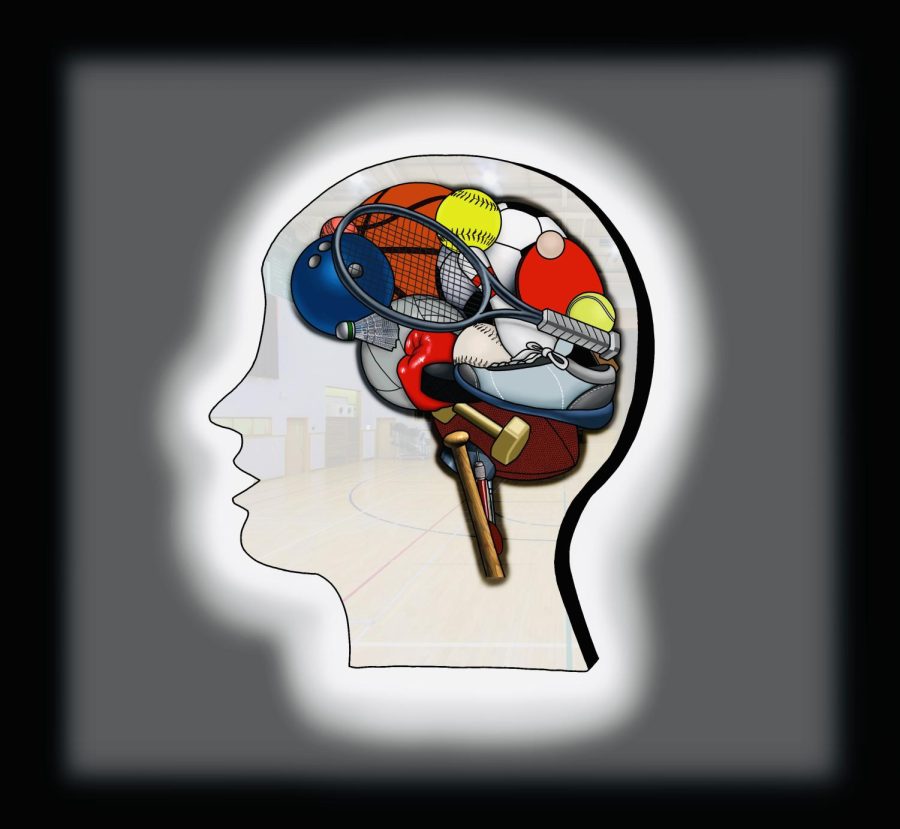Graphic by ChaeUn Son.
We Think, Therefore We Play
All You Need to Know About Athletics and Psychology
March 28, 2023
“Jets on Three! One! Two! Three!…. JETS!” This familiar chant that DIS athletes roar on the top of their lungs shows off more than just team spirit.
Athleticism defines us (Ricky and Sarah) – our sports career dates all the way back to preschool. From short-distance track, basketball, futsal, to volleyball, there isn’t a sport we haven’t attempted. Then, during sophomore year, we enrolled in what became our favorite class: AP Psychology. And through this course, we came to realize the intricate relationship between the science of the body and the mind. We also discovered that group cheers possess a hidden function.
Through research on sports psychology, which explores how mental processes influence athletic ability and physical health, we figured out that performance and mentality heavily rely upon each other. With trending topics in social media and the growing field of mindfulness in sports, to learn basic knowledge about psych proves useful. From one athlete to another, here is some insight to unlock your best potential when you step onto court.
Intrinsic Motivation
Intrinsic motivation describes the passion that comes from within, not from external pressure such as resume-building or pleasing your coach. Self-provided catalysts urge us to go above and beyond when we play. Constant involvement in SKAC (Southern Korean Activities Conference) games, leadership in a sports-related lunch club, and score-keeping at tournaments – we do this purely for the love of the game.
Athletes who demonstrate intrinsic motivation show more dedication, involvement, and they genuinely enjoy playing. The strong desire to improve encourages us to focus on growth rather than just look for immediate outcomes; therefore, we get more excited to train and compete. Successful results and increased satisfaction sparks more ambition and allows the healthy cycle to repeat.
Groupthink
Groupthink refers to a situation in which members of a group prioritize consensus and agreement over independent decisions. Although teams function better together, a high level of cohesion within the group and a desire to maintain it can lead to lack of open discussions, and ultimately, failure to consider alternate perspectives.
Team captains sometimes make sole decisions because members don’t feel comfortable enough to express concerns. To avoid this, athletes should support open debate among members regardless of possible cognitive dissonance. Coaches and leaders should encourage independence and create an environment in which players feel comfortable enough to voice concerns.
Ingroup Bias & Group Polarization
The majority of sports games involve team play. Together, we fight and dedicate ourselves to the victory of the group. This leads to an ingroup bias, a psychological concept that refers to the tendency of preferring individuals from one’s own group above others. DIS students only cheer for DIS teams, for instance. However typical, this tendency to favor ‘my own team’ can lead to group polarization among students who compete against each other.
Group polarization causes individuals to take extreme perspectives after interactions with others who think the same way as they do. Influenced by ingroup bias and groupthink, this leads athletes and fans to go wild and cross the boundary of good sportsmanship. HIS (Handong International School), for instance, is known for their aggressive cheering. While they start easy, students get intense by the end of the game. With positive utilization, though, group polarization can help teams bond for a singular goal.
Adrenaline
Adrenaline – a hormone produced in response to stress, fear, and excitement – plays a key role in sports. When faced with the high-pressure of a challenge such as a game-winning shot or a critical play, our body releases stress hormones. This sudden surge produces a range of physical and psychological effects, including an increased heart rate, heightened focus, and a burst of energy and strength. A sufficient amount of an adrenaline rush can support our performance, but too much of it rather obstructs focus.
Social facilitation
Audience is a key part of a game. Crowds can greatly impact performance in the midst of a tournament. Social facilitation, a phenomenon in which being in the presence of others affects our actions, poses both positive and negative influence on our play, especially because of the collaborative nature of sports competitions.
For instance, a game held at DIS means that we get the home-court advantage of having our own supporters in the bleachers. This presence of audience increases arousal and enhances performance on simple, well-learned tasks. On the other hand, with inexperienced athletes that lack confidence in certain skills, the pressure backfires and leads to worse results.
Game Time
Including but not limited to the examples above, countless factors lay behind the scenes of sports. Athletes and coaches utilize various psychological strategies to maintain focus and confidence even in the face of heavy pressure. Keep in mind the 5 concepts we outlined in our story and we guarantee growth in your chosen athletic field. Positive team culture and a sense of social support and affiliation can shape us into something beyond expectation.

Henry • Mar 29, 2023 at 7:30 pm
I learned lots of things when I read this. There is a lot of new information here.
Jio Kim • Mar 29, 2023 at 7:24 pm
I really like psychology and how sports all connect to psychology! It’s was cool to read about it!